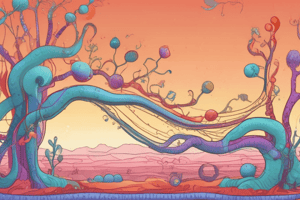Podcast
Questions and Answers
Match the stages of cellular respiration with their descriptions:
Match the stages of cellular respiration with their descriptions:
Glycolysis = Breakdown of glucose into pyruvate Krebs Cycle = Oxidation of acetyl-CoA to CO2 Electron Transport Chain = Production of ATP via oxidative phosphorylation Fermentation = Anaerobic conversion of sugars to acids or gases
Match the molecules produced in cellular respiration with their roles:
Match the molecules produced in cellular respiration with their roles:
ATP = Main energy carrier in cells NADH = Electron donor in the electron transport chain FADH2 = Carrier of electrons and protons during respiration CO2 = Waste product of aerobic respiration
Match the location of each step of cellular respiration in eukaryotic cells:
Match the location of each step of cellular respiration in eukaryotic cells:
Glycolysis = Cytoplasm Krebs Cycle = Mitochondrial matrix Electron Transport Chain = Inner mitochondrial membrane Lactic Acid Fermentation = Cytoplasm
Match the type of respiration with the conditions in which they occur:
Match the type of respiration with the conditions in which they occur:
Match each enzyme with its function in cellular respiration:
Match each enzyme with its function in cellular respiration:
Flashcards are hidden until you start studying
Study Notes
Stages of Cellular Respiration
- Glycolysis: Occurs in the cytoplasm, breaks glucose into pyruvate, producing a net gain of 2 ATP and 2 NADH.
- Krebs Cycle (Citric Acid Cycle): Takes place in the mitochondria, oxidizes pyruvate to CO2, generates 2 ATP, multiple NADH, and FADH2.
- Electron Transport Chain: Located in the inner mitochondrial membrane, uses NADH and FADH2 to produce about 28-34 ATP through oxidative phosphorylation.
Molecules Produced in Cellular Respiration
- ATP: Primary energy currency of the cell, used for various cellular processes.
- NADH and FADH2: Electron carriers that transport high-energy electrons to the electron transport chain.
- CO2: A waste product generated during the Krebs cycle, expelled during respiration.
Location of Each Step of Cellular Respiration
- Glycolysis: Takes place in the cytoplasm of the eukaryotic cell.
- Krebs Cycle: Occurs in the mitochondrial matrix.
- Electron Transport Chain: Found in the inner mitochondrial membrane.
Types of Respiration and Their Conditions
- Aerobic Respiration: Requires oxygen; takes place in most eukaryotic organisms, significantly more ATP is produced.
- Anaerobic Respiration: Occurs without oxygen; results in less ATP and produces byproducts such as lactic acid or ethanol.
Enzymes and Their Functions in Cellular Respiration
- Hexokinase: Catalyzes the phosphorylation of glucose to glucose-6-phosphate during glycolysis.
- Aconitase: Transforms citrate into isocitrate in the Krebs cycle.
- Succinate Dehydrogenase: Converts succinate into fumarate, reduces FAD to FADH2 in the Krebs cycle.
- ATP Synthase: Uses the proton gradient from the electron transport chain to synthesize ATP from ADP and inorganic phosphate.
Studying That Suits You
Use AI to generate personalized quizzes and flashcards to suit your learning preferences.




